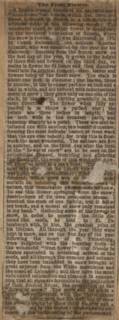
Edwin Moses Hale to Asa Gray
Click on image to enlarge
124 Clark St.
Chicago, June 13
Prof. A. Gray:
Dear Sir:
I cut the enclosed from a newspaper a month or two ago. I have a suspicion that it is a hoax *, but my curiosity is such that I would like to have you give me your opinion or knowledge concerning it.
Yours truly,
E.M. Hale,
Prof Med. Bot. et Mat. Med.
* Yes, and a neat and amusing one!
A.G.

The Frost Flower Newspaper Clipping
Click on image to enlarge
The Frost Flower.
A Boston journal describes an extraordinary “frost flower” of Russia, which has been produced, it is said, in Boston in a temperature of artificial cold, in the following words: This wonderful plant, or rather flower, is found only on the northern boundaries of Siberia, where the snow is eternal. It was discovered in 1853 by Count Swinoskoff, the eminent Russian botanist, who was ennobled by the czar for his discovery. Bursting from the frozen snow on the first day of the year, it grows to the height of three feet and flowers on the third day, remains in flower for 24 hours and then dissolves itself into its original element – stem, leaves and flowers being of the finest snow. The stalk is about 1 inch in diameter; the leaves, three in number, in the broadest part are an inch and a half in width, and are covered with infinitessimal cones of snow; they grow only on one side of the stalk, to the north, curving gracefully in the same direction. The flower when fully expanded is in shape a perfect star; the petals are three inches in length, half an inch wide in the broadest parts, and tapering sharply to a point. These are also interlaced one with another, in a beautiful manner, forming the most delicate basket of frost work that the eye ever beheld; for truly this is a frost-work the most wonderful. The anthers are five in number, and on the third day after the birth of the “flower of snow” are to be seen on the extremities thereof, trembling and glittering like diamonds, the seeds of this wonderful flower, about as large as a pin’s head. The ??? botanist says that when first he beheld this flower “I was dumb with astonishment; filled with wonderment, which gave way to interest (?) most ecstatic on beholding this wonderful work of nature, this remarkable phenomenon of snow, To see this flower springing from the snowy desert – born of its own composite atoms. I touched the stem of one lightly, but it fell at my touch, and a morsel of snow only remained in my hand.” Gathering some of the flowers in snow, in order to preserve the little diamond like seeds, he hied to St. Petersburgh with, to him, the greatest prize of his lifetime. All through the year they were kept in snow, and on the first day of the year following the court of St. Petersburg, were delighted with the bursting forth of the wonderful “frost flower!” Our friend in Boston succeeded in obtaining several of the seeds, and all through the summer and autumn they have been embedded in snow brought at great expense from the White mountains and the coast of Labrador; and they have the most unbounded satisfaction and pleasure in announcing that all signs are favorable to the realization of their fondest hopes, the production of the “flower of snow.” The snow and ice are in a large glass refrigerator, with the thermometer 45 degrees below zero, and the solid bed of snow has already begun to show little fissures and a slight parting (?) in the centre; unmistakable evidence of the forthcoming of the phenomenon.
No comments:
Post a Comment